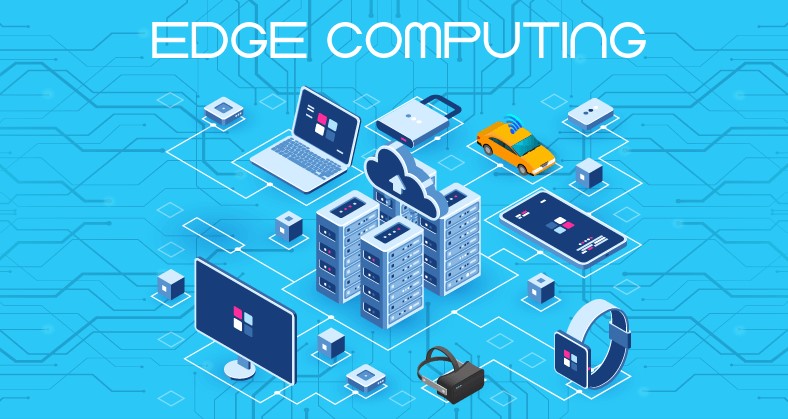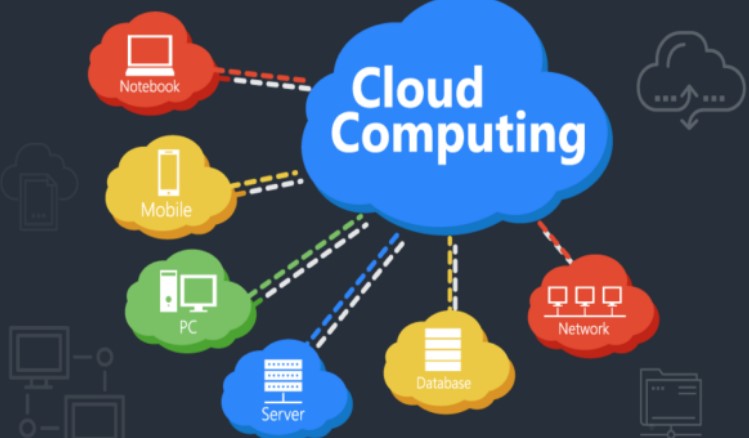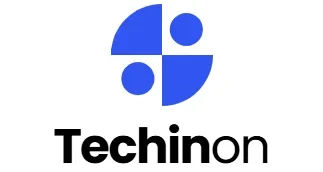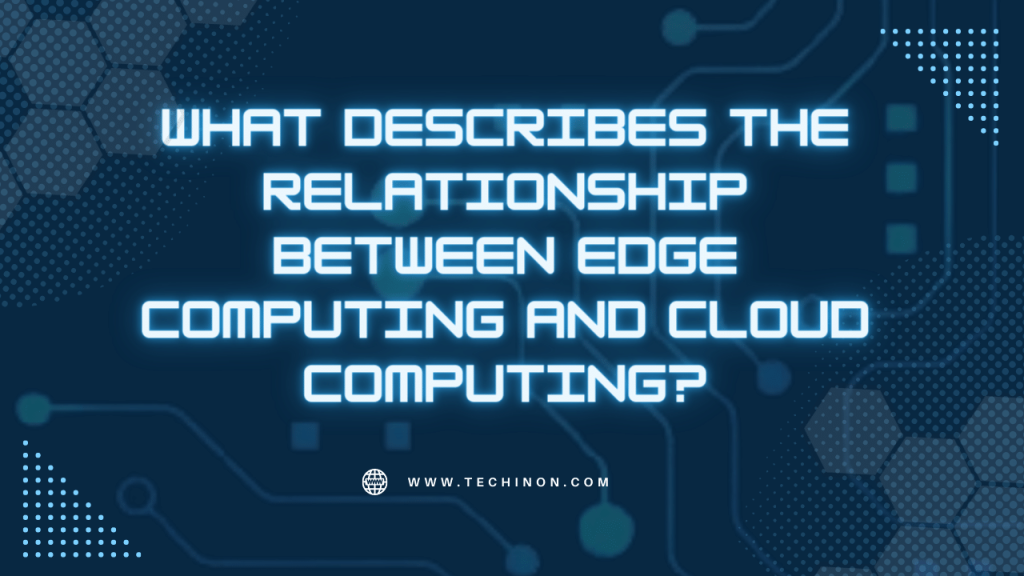Understanding the intricate dance between edge computing and cloud computing is essential for the evolving digital landscape. In the realms of big data and the Internet of Things (IoT), this duo forms a formidable alliance that brings speed, efficiency, and scalability to our fingertips. Our journey begins with understanding about “What Describes the Relationship Between Edge Computing and Cloud Computing?”.
What is Edge Computing?

Edge computing refers to a decentralized computing infrastructure, where data processing occurs close to the source of data, known as the ‘edge’ of the network. This paradigm emphasizes swift response times and efficient data processing, minimizing latency issues that could hinder operational efficiency.
What is Cloud Computing?

Cloud computing, on the other hand, represents a centralized model where data processing and storage happen on remote servers accessed via the internet. It is revered for its scalability, resource optimization, and cost-effectiveness, enabling businesses to adapt swiftly to fluctuating demands.
Edge-Cloud Collaboration: A Symbiotic Relationship
Despite their contrasting natures, edge computing and cloud computing are not mutually exclusive. Instead, they work together in what’s often referred to as an edge-cloud collaboration or cloud-edge integration. This model represents a seamless interplay between the centralized nature of cloud computing and the decentralized approach of edge computing.
Edge computing can handle immediate data processing demands on the spot, reducing latency and bandwidth usage, while cloud computing serves as the comprehensive data management and processing hub, handling more complex and resource-intensive tasks. This synergy leads to a robust, adaptive system capable of handling a variety of workloads and operational scenarios.
Hybrid Cloud-Edge Architecture: The Best of Both Worlds
In a hybrid cloud-edge architecture, data processing tasks are intelligently distributed between the edge and the cloud. Simple, time-sensitive tasks are performed at the edge, while more complex, non-time-critical tasks are sent to the cloud. This unique approach optimizes operational efficiency, enhancing data security and privacy without compromising accessibility and flexibility.
Edge-to-Cloud Connectivity: The Role of Fog Computing
Fog computing, a pivotal concept in cloud-edge integration, provides a bridge between the cloud and edge devices. This model enables seamless data exchange, enhancing edge-to-cloud connectivity while ensuring optimal performance, even in bandwidth-constrained environments.
Advantages of Cloud-Based Edge Services
Cloud-based edge services encompass a wide array of features, from edge analytics to edge data processing. These services bring the power of the cloud to the edge, offering resource-intensive capabilities like machine learning and complex data analytics in a decentralized manner.
Edge Computing Networking and Security
Security remains a paramount concern in any IT infrastructure, and the cloud-edge paradigm is no different. Edge computing networking involves secure, efficient data transmission, while cloud-edge security encompasses safeguarding data from threats at both ends of the spectrum. The unique characteristics of edge and cloud computing necessitate specialized security approaches to ensure the integrity and confidentiality of data.
Pioneering the Future: Distributed Cloud Computing and Edge Computing
In the quest for faster data processing and minimized latency, a novel concept, known as distributed cloud computing, has emerged. Distributed cloud is an extension of cloud computing, where cloud services are distributed to different physical locations, but the operation, governance, updates, and evolution remain the responsibility of the public cloud provider.
Here, edge computing serves as the perfect companion to distributed cloud computing. In essence, the decentralized nature of edge computing becomes an extension of the distributed cloud, allowing for a seamless flow of data from the edge devices to the cloud. Edge devices can make real-time decisions, while the distributed cloud offers broader analysis and deeper insights, making it an ideal setup for real-time applications like autonomous driving, industrial IoT, and more.
Edge Computing Platforms: An Essential Cog in the Wheel
In the realm of edge computing, dedicated edge computing platforms play a crucial role. These platforms provide an essential infrastructure layer that enables developers to deploy application logic closer to data sources – IoT devices, edge servers, or end-users. They provide a range of services like edge data processing, device management, data synchronization, and others, which are integral to the cloud-edge workflow. Cloud providers, recognizing the importance of these platforms, offer edge computing services that extend their cloud services to the edge, leading to a seamless and integrated edge-cloud experience.
The Role of Edge Analytics in the Edge-Cloud Duo
Edge analytics is another vital aspect of the edge-cloud paradigm. It involves analyzing data at the edge of the network, near the source, in real-time. This approach has several advantages – it reduces the amount of data that needs to be transferred to the cloud, allows for faster decision making, and provides immediate insights. When combined with cloud computing’s capabilities for more intensive data analysis and long-term storage, edge analytics makes for a formidable ally, paving the way for more efficient, insightful data processing.
Cloud-Edge Deployment Models: Mapping the Path to Integration
To better understand the interplay between edge and cloud computing, it’s crucial to consider different cloud-edge deployment models. Each model highlights a different aspect of the relationship, such as:
- Cloud-centric model: Here, the cloud provides core services, while the edge is used for specific use-cases that need lower latency or have bandwidth constraints.
- Edge-centric model: In this model, edge computing plays the leading role in processing and storing data. The cloud is used for tasks like long-term data storage, intensive data analytics, and other resource-heavy tasks.
- Balanced cloud-edge model: This model sees a balanced use of both cloud and edge, with data processing and storage tasks distributed intelligently based on parameters like data type, latency requirements, and bandwidth availability.
Each model demonstrates a different facet of the cloud-edge relationship, showing the versatility of this duo.
Use Cases: Where Edge and Cloud Computing Shine
There are several areas where the integration of edge computing and cloud computing delivers exceptional value:
Healthcare: Real-time patient monitoring devices use edge computing for immediate analysis and alerts, while the cloud stores long-term patient data and runs complex analyses for trend prediction and treatment planning.
Manufacturing: On the factory floor, edge computing aids in real-time quality control and anomaly detection, while the cloud is used for predictive maintenance, supply chain optimization, and more.
Retail: Edge computing enables real-time inventory tracking and personalized in-store customer experiences, while cloud computing handles larger-scale analytics, inventory forecasting, and customer behavior analysis.
The flexibility, speed, and efficiency offered by edge-cloud integration make it an invaluable asset across various sectors.
Cloud-Edge Synchronization: The Art of Balancing
In any cloud-edge setup, synchronization plays a key role. Ensuring seamless,consistent data flow between the edge and the cloud is essential for maintaining the overall system’s integrity. Both data and application states must be synchronized to ensure coherent operation and reduce conflicts or redundancies.
Edge Computing and Cloud Computing: The Road Ahead
The marriage of edge computing and cloud computing signifies a critical step forward in our digital evolution. With the explosion of IoT devices and an ever-increasing demand for real-time, data-driven services, this harmonious union is setting new standards for operational efficiency, scalability, and performance.
But it’s not without its challenges. From security concerns to deployment complexities, the road to perfect integration is fraught with hurdles. Yet, the benefits far outweigh these challenges. Organizations worldwide are beginning to recognize the immense potential of edge and cloud computing, adopting hybrid models to leverage the strengths of both.
As we stand on the cusp of this transformation, one thing is clear: the future of computing lies not just in the cloud, nor at the edge, but in the potent synergy between the two. The ongoing collaboration between edge and cloud computing is set to revolutionize industries, redefine user experiences, and pave the way for technological innovations that we are yet to imagine.
Edge Computing and Cloud Computing: Frequently Asked Questions
What is the difference between edge computing and cloud computing?
While edge computing processes data near its source for low latency, cloud computing involves data processing and storage on remote servers for improved scalability and resource optimization.
Can edge computing replace cloud computing?
No, edge computing cannot replace cloud computing. They serve different purposes and often work together to offer optimized data processing solutions.
What are the benefits of combining edge computing with cloud computing?
The combination of edge and cloud computing offers a balance of speed, scalability, and efficiency, effectively handling varying workloads while mitigating latency issues and optimizing resource usage.
What are the security considerations when using edge computing and cloud computing together?
Security in the cloud-edge paradigm involvessafeguarding data during transmission and storage, implementing robust authentication protocols, and ensuring the privacy and integrity of data in both environments.
Are there any specific industries that benefit from the integration of edge computing and cloud computing?
Several industries, such as healthcare, manufacturing, retail, and transportation, can benefit from integrating edge computing and cloud computing. These sectors often deal with time-sensitive data that require swift processing (edge computing) and massive amounts of data that need scalable, efficient storage and processing (cloud computing).
Also Read: Acculturation AP Human Geography: A Detailed Note [2023]
Final Thoughts On What Describes the Relationship Between Edge Computing and Cloud Computing?
In the grand symphony of digital transformation, edge computing and cloud computing are two harmonious notes that create a beautiful melody when played together. They represent a holistic, adaptive approach to data processing that addresses varying business needs and operational challenges. Embracing this cloud-edge paradigm is not just a wise move; it’s an inevitable step in the ongoing journey of digital evolution. By leveraging this powerful duo, businesses can unlock unprecedented levels of speed, scalability, and operational efficiency, propelling them towards a future of limitless possibilities.
Iva Ort is an ingenious wordsmith and captivating blogger whose tales leap off the screen and into your imagination. With a pen as her wand, she weaves enchanting stories and insightful articles, leaving readers spellbound and craving more.

